The pandemic has been a testing time for the travel sector, but Uber has managed to adapt its strategy to power through adversity and maintain a level of trust with young consumers.
Gen Z students have grappled with a number of changes to their daily routines since the pandemic took hold last year. How brands have responded to the coronavirus pandemic has become an important factor in how they are perceived by Gen Z. Our latest Youth Brand Affinity Tracker results see Uber take the top spot in the travel sector for the second quarter in a row. Our sister company, Voxburner, recently caught up with Uber’s Ceili Hubbard during YMS:Online, to discuss how the brand has increased Gen Z engagement during the pandemic. Here are just three of the methods that helped Uber achieve success with the student demographic this quarter:
Innovation and digital solutions
Uber is renowned for its innovation – the brand itself was built upon a unique idea that has transformed the travel sector – but maintaining this reputation becomes a challenging feat for a travel company when the world is forced to stop moving. As such, Uber had to pivot away from their usual set of goals and priorities, in order to play an active role in keeping communities across the globe safe during the pandemic.
The results? Uber launched new policies and features as part of their Door-to-Door safety initiative, supported by effective digital campaigns to target their audience. As well as implementing a mandatory mask policy for riders and drivers, and suspending their Uber pool product to adhere to COVID guidelines, Uber launched new safety products using innovation and gamification – both of which Gen Z loves. An example is their mask verification technology, which asks riders and drivers to verify that they are wearing a mask by taking a selfie – a creative method that also taps into Gen Zs’ digital vocabulary.
View this post on Instagram
Digital campaigns that ran alongside these new features included their ‘No mask, no ride’ initiative, designed to highlight the brand’s commitment to health and safety. Extensive digital marketing and inclusive messaging has no doubt aided their brand visibility among young consumers in the US, which has skyrocketed to 89% this quarter, compared to 64% in Q4 2020.
Community-led campaigns
As well as launching innovative technology in light of the COVID crisis, Uber has taken steps to adapt the way it uses its services and alter their messaging. The brand launched a global campaign called #MoveWhatMatters, to provide free meals and 10 million free rides to healthcare workers. This campaign also wavers delivery fees for independent restaurants and delivers millions of health and safety supplies to drivers around the world. More recently, they have provided free trips to vaccination hubs as part of the campaign.
“Since the world wasn’t moving, we were faced with the challenge of what role Uber could play in that kind of new environment and really, our focus came down to doing the right thing and how Uber could play a role that would actually benefit society.” – Ceili Hubbard, brand marketing, UK & Ireland, Uber
Uber’s #EverydayGiants campaign is a huge nod to the concerns of young people in the community, who value authenticity and ethical workplace treatment. The campaign celebrates drivers and delivery people who have made a ‘giant’ impact during difficult times. As well as posting dedicated social media activity, Uber painted murals across the US of their hero drivers – seamlessly blending the online space with the real world.
View this post on Instagram
The brand has also taken action to protect their workers, allocating $50 million dollars to purchase health and safety supplies for drivers and delivery people across the globe. Their authentic and genuine approach is clearly making waves among the young consumer demographic – Uber’s brand advocacy among Gen Zs in the US increased to 47% this quarter.
UberEats
UberEats was a tool for comfort and familiarity during the pandemic, as it brought people’s favorite takeaway and restaurant brands into the home when going out to eat was no longer an option for so many – and Uber made sure they stood out from their competitors to keep themselves top of mind.
As a generation that has never known a world without the internet, Gen Z are accustomed to getting what they want at the touch of a button. Uber has been a big part of this mentality with their ride and food services, and they continue to value the importance of young consumers who are native to in-app services and instant gratification.
Gen Z responds well to social media and influencer marketing – 82% of US students follow at least one influencer with 5k+ followers – and UberEats continue to boost their celebrity partnerships and online presence during the pandemic. More recently, they partnered with Wayne’s World and Cardi B as part of their #EatLocal message – turning their marketing and messaging into something that resonates with young consumers, helping to boost their purchase intent with US students from 26% to 42% this quarter
Want to know how Gen Z perceives your brand? Find out by accessing our latest Youth Brand Affinity Tracker.














